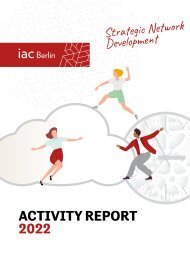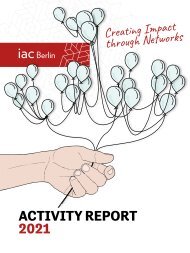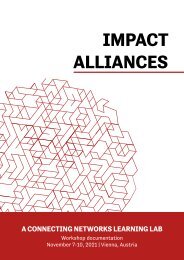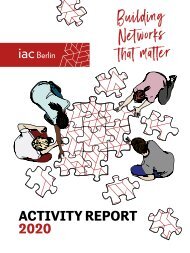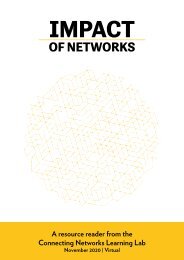Addressing Grand Challenges Collectively: An introduction to impact-oriented networks
Background and introduction paper on impact-oriented networks
Background and introduction paper on impact-oriented networks
You also want an ePaper? Increase the reach of your titles
YUMPU automatically turns print PDFs into web optimized ePapers that Google loves.
First, compared <strong>to</strong> the public sec<strong>to</strong>r, foundations have limited resources at their disposal.<br />
This holds true not only for finances, but also for staff and political power. This limitation<br />
becomes even more apparent in the face of the substantial social and environmental challenges<br />
of the 21st century. Moreover, foundations face serious questions around accountability<br />
and transparency that can ultimately challenge their legitimacy, especially in turbulent<br />
political times. 61 Second, grant-giving that focuses on covering costs rather than building<br />
capacity in organizations has been criticized as ineffective or even counterproductive. 62<br />
Philanthropy therefore can and should go beyond the provision of financial capacity <strong>to</strong><br />
others. As Jodi Sandfort highlighted, the <strong>to</strong>olkit of philanthropy may also include powerful<br />
micro-level tactics such as convening key ac<strong>to</strong>rs, influencing public opinion, conducting research,<br />
and building <strong>networks</strong>. 63 Sandfort’s argument reveals a close fit with activities related<br />
<strong>to</strong> being part of, forming, or maintaining an <strong>impact</strong>-<strong>oriented</strong> network:<br />
1. Convening fosters network-building—not only by building social capital, but also<br />
by focusing attention on a particular issue. Convening key ac<strong>to</strong>rs requires infrastructure<br />
such as physical or virtual meeting places, or a foundation’s brand <strong>to</strong> lend<br />
legitimacy <strong>to</strong> a new network.<br />
2. Communicating <strong>to</strong> influence public opinion can give a network a voice; here a<br />
philanthropic institution’s influential position and societal relevance can be crucial<br />
for amplifying a message.<br />
3. Conducting research on social problems or supporting such research is helpful for<br />
<strong>impact</strong>-<strong>oriented</strong> <strong>networks</strong> in two ways. It generates evidence around a social issue<br />
for use by the network, thereby providing both direction for <strong>impact</strong>ful action and<br />
orientation for future allies, network members, and the general public. Furthermore,<br />
basing activities on research can strengthen the activities’ legitimacy and, in turn, the<br />
legitimacy of the network.<br />
4. Building <strong>networks</strong> <strong>to</strong> mobilize responses is central <strong>to</strong> <strong>impact</strong>-<strong>oriented</strong> <strong>networks</strong>.<br />
With the possible exception of research, all of these <strong>to</strong>ols reflect core functions of impac<strong>to</strong>riented<br />
<strong>networks</strong>.<br />
5.2. Creating high-functioning <strong>impact</strong>-<strong>oriented</strong> <strong>networks</strong><br />
Accepting the proposition that <strong>networks</strong> provide a meaningful way <strong>to</strong> create <strong>impact</strong> and are<br />
a fitting <strong>to</strong>ol for philanthropic institutions, the next logical step is <strong>to</strong> ask how this <strong>to</strong>ol can<br />
be used. Given the novelty of <strong>networks</strong> in the context of <strong>impact</strong> and philanthropy, prior<br />
research provides little guidance on what constitutes a high-functioning <strong>impact</strong>-<strong>oriented</strong><br />
network. A helpful exception is the pioneering work of Jane Wei-Skillern and colleagues. 64<br />
First, Jane Wei-Skillern and Nora Silver argued that nonprofit leaders and funders should<br />
look at the potential long-term <strong>impact</strong> of <strong>networks</strong> when considering whether <strong>to</strong> engage<br />
with them. 65 Investing in <strong>networks</strong> may not result in tangible short-term outcomes and even<br />
if so, outcomes will likely not be attributed <strong>to</strong> a single organization, but <strong>to</strong> the network. 66<br />
However, an investment in <strong>networks</strong> can allow organizations <strong>to</strong> create <strong>impact</strong> at a scale that<br />
is impossible <strong>to</strong> reach alone.<br />
61 Reich (2019)<br />
62 Letts (1997)<br />
63 Sandfort (2008)<br />
64 Wei-Skillern and Marciano (2008), Wei-Skillern (2010), Wei-Skillern and Silver (2013)<br />
65 Wei-Skillern and Silver (2013)<br />
66 Wei-Skillern and Silver (2013)<br />
22




